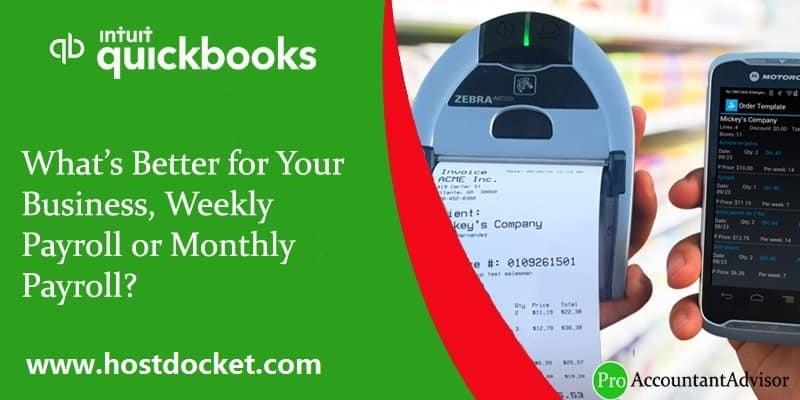No doubt, QuickBooks is an exceptional accounting and bookkeeping software made possible by Intuit. This software possess all functionalities that every business regardless of the size and type requires. One of the most important functions that is offered by QuickBooks is payroll. But it has always been a debatable topic to decide whether Weekly Payroll is better or Monthly Payroll is better. To help the users in this confusion, we have tried to project the purposes of both payroll methods. Along with unbiased pros and cons with the help of this article. Thus read the article till the end, or for any further information, you can make a call at our toll-free number .i.e. +1-844-499-6700.
Empowering employees is a symbol of growth. But at the same time it comes with important decisions and responsibilities, including payroll. Once the user sort out the legal requirements, you’re left with the settlement of how often to run payroll. Weekly, biweekly, and monthly payroll are the most common choices with some pros and cons of each to consider. So, without further delay, let us begin with the discussion.
Understand Weekly Payroll
Sending out weekly pay cheques follows in processing payroll 52 times per year and incurring the relevant service fees each week, whether you run payroll in-house or outsource it. Employees earn their pay-cheques on the same day each week, usually on Friday, for the salaries, hourly, and/or overtime pay they received over the seven-day span the cheque covers.
Pros of Weekly Payroll
- A large number of employees enjoy getting paid every week. And also, it keeps a patterned movement of money reaching into their bank accounts. This makes it easier to budget household finances. In situations when an hourly employee works overtime, they are paid for those extra hours sooner preferably than having to pause two weeks or even till the end of the month to get the extra money. That can be particularly helpful if the weekly schedule alters significantly.
- For instance, if an employee manages to reach 65 hours one week and only 25 hours the next week, this method is helpful to have that extra overtime pay way before heading into the lighter schedule week. If the user recommend weekly payroll, then this could be considered as high employee happiness.
- On the user’s end, calculating overtime is an honest process, especially when there is hourly employees on staff. Since the pay period tallies with the work week, it becomes much easier to calculate any additional pay. With monthly pay periods, the first and last week of the month is typically partial weeks, which can hamper the calculations. Weekly pay periods also make it smoother to comprehend when timecards or time reports are payable.
- In this method, the payable date remains the same every week as the user will run payroll on the same day each week. Whereas, on a monthly inventory, the cut-off for turning in pay may vary from one month to the next depending on end of the month.
Read Also: How to Fix QuickBooks Error Code 80040408?
Cons of Weekly Payroll
- As it is rightly said, everything comes with its pros and cons, and talking about weekly pay, there are certain cons of this as well. One of the biggest disadvantages of weekly payroll for the employer is the time plus cost. Since the employer is following weekly payroll, that can take the employer away from other duties, or it indicates the staff member appointed to handle payroll gets drawn away from other duties. If someone is picked to do payroll, they get paid each time it’s run, improving the overhead.
- Distributing pay more often might at times come at a cost if you issue conventional paper cheques, wasting money on the cheque forms and the ink to print them. If the user makes use of direct deposit, he/she might have to pay a small fee per deposit depending on the service that is practiced. Paying those fees every week adds up to the total cost. That fees can be cut off in half by preferring biweekly or monthly pay periods.
See Also: What are the advantages of using QuickBooks Pro Software beside bookkeeping
Understand Bi-weekly Payroll
When the user runs payroll every other week that results into 26 pay times per year, as maximum months have two paydays, but some months have three. Similar to weekly pay period structure, the bi-weekly structure means that the employees will get paid on the corresponding day of the week each time, but only all another week.
Thus, the employer might pay them all Friday, just for an example. The biweekly option is a bit different than paying employees semimonthly, where they always get just two paycheques per month, for a total of 24 pay periods. In general, a semimonthly plan typically pays employees on the 15th and the last day of the month rather than paying every another week.
Pros of Biweekly Payroll
- Biweekly payroll brings in certain pros, a few of which are mentioned in this paragraph. Balanced to a weekly payroll schedule, bi-weekly payroll frees the employer a notable amount of time since they simply have to run it every other week. This method saves money on direct deposits and cutting cheques, since these tasks are done half as many times per year. Running payroll less frequently also signifies less risk of error.
- Running payroll weekly means that the employer has more possibilities to include human error into the equation. Not only this, the biweekly payroll also adjusts well with the work weeks, which makes it easy to add overtime for the two weeks that fall into each pay period.
Cons of Biweekly Payroll
- Talking about the disadvantage, biweekly payroll adjusts the monthly expenses with the pay periods. This means that when the employer runs payroll monthly, it becomes easy for him to determine monthly thoughts. Whereas with weekly and biweekly payroll, the first and last paydays of each month often actually span two separate months, which creates disturbance.
- The first pay cheque in March may include a few days from February, while the last pay cheque might cover a few days of April. (For example, adding some complexity to concluding calculations.)
You may also read: Intuit Payroll: QuickBooks Smarter Payroll & E-Taxes
Understand Monthly Payroll
Now comes the monthly payroll, and if the employer uses monthly payroll, then payroll is run only once a month. And the employees solely receive one paycheque per month that makes a total of 12 cheques per year. Also, the precise date gets altered. For instance, the user runs a payroll each month on the 20th. Monthly payroll isn’t as prevalent anymore.
Employers don’t receive any huge benefits for only running payroll once per month, and it’s offensive with employees as it might create complications in budgeting.
Pros of Monthly Payroll
One of the most significant fact about monthly payroll is that, it is easy to handle and the employer is required to invest his time in payroll only once per monthly. Not only this, but also it adjusts well with all the payroll deductions that are required, such as taxes, Canada Pension Plan contributions, as well as Employment Insurance premiums. This would otherwise be divided over various cheques per month, whereas with the help of monthly payroll, the employer can use the full amount out of the single cheque for each of the employee.
Cons of Monthly Payroll
- The monthly payroll lacks behind as there are certain regions that wish to pay their employees more frequently. In British Columbia, as per the rules the companies have to pay their employees at least double per month. This suggests that the employer needs to at least opt for a semimonthly pay period, which means to pay the employees twice per month, which is in general on the 15th and the last day of the month. There are many other laws for salaried versus hourly employees in other regions. Such as in Saskatchewan, if the employers employ monthly salaried employees, then they can pay them on a monthly basis, however, for all other employees, paying at least semi monthly is mandatory.
- The issue with monthly payroll doesn’t end over here, it adds up to employee redemption. Most of the times, employees find it difficult to stretch their money out over the complete month. Most bills get due on a monthly basis. For this the employees should be ready to pay their bills when they get their pay cheque. And further budget the rest for the other expenses, but this sounds too theoretical. In actual, it becomes challenging for the employees to proportion their money for the entire month. Especially for the ones who live pay cheque to pay cheque. If the employee faces trouble establishing a monthly budget routine, they might find it difficult to manage until they are paid again, which piles up to their difficulties.
Deciding Between Payroll Options
As stated before, deciding between the two has always been confusing for the employers. But before jumping on to any conclusion, the user should make note of the payroll ordinances in that particular region. Where they have set up their company. If the employer is situated in a region that demands two pay periods per month, then in that case monthly payroll might not be a better option. Once the employer gets familiarize with the laws, the user can measure the pros and cons of the particular events. Moreover, a frequent payroll period assists the employees avoid having “more month at the end of the money”.
Staring at the costs and time involved in many payroll options can help you pick what’s best for you. A biweekly pay structure is oftentimes a good balance amid keeping employees happy and balancing your costs without scoring to your bookkeeping or financial burden.
Read Also: How to Fix QuickBooks runtime problems?
Changing Your Payroll Frequency
If the user have employees but are considering payroll frequency, then take some time to handle the change. The move may turn the math. If you’re using payroll software, then the program controls the calculation changes for the employer. This is one of the significant perks of using computerized payroll systems. Likewise, in case of outsourcing payroll, the vendor would manage the changes in calculations. The user is required to keep in mind that he/she might have to pay more. If he/she boosts the frequency of payroll as the provider may charge for every run.
Prepare the employees for any adjustments in payroll. It is a sensible idea to let the employees know at least a month in advance about the various aspects. In case the employee is moving to a shorter pay period. Such as shifting from monthly to biweekly, the employees are expected to acknowledge the change. And won’t need a long lead time before the switch. Whereas, moving from paying weekly to biweekly requires presenting the employees ample notice. So that they’re qualified to go longer within paycheques.
At the time of deciding on the frequency of pay periods, the employer eventually should attempt to gain a balance among a cost-effective solution for employer and a schedule. This would keep the workforce comfortable. Considering the pros and cons of various regularities would help the employer to find that balance. And finding the right payroll solutions makes it simpler to process payroll no matter how frequently it is done.
Reference Site: https://quickbooks.intuit.com/ca/resources/payroll/weekly-biweekly-or-monthly-payroll/
Conclusive words
Did you know you can pay employees in QuickBooks? Simply Add Payroll today. However, in case any of your queries remained unanswered, then feel free to seek help and guidance from our QuickBooks payroll customer service team by calling them on their toll-free number at +1-844-499-6700.
They are Intuit Certified ProAdvisor and the industry’s best accounting experts, they provide round the clock service. We would love to be your support partner!
FAQs Related to Weekly, Bi-Weekly or Monthly Payroll
Even though the pay frequency changes, the amount remains the same. However, a biweekly pay schedule makes it easier to reduce debt or save more money.
Bi-weekly and bimonthly can mean the same thing, which means occurring twice in a week or month respectively. Bi-weekly means twice in a week or every other week. Whereas, Bimonthly means every other week, if it’s twice a month or it can mean every other month.
Due to the consistency and cash flow predictability offered by semi-monthly, it is best suited for salaried workers. Hourly employees should be paid biweekly or weekly
Articles to read:
Steps to resolve QuickBooks error 6007




